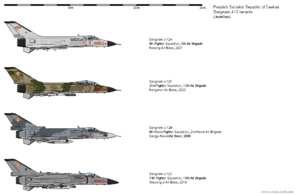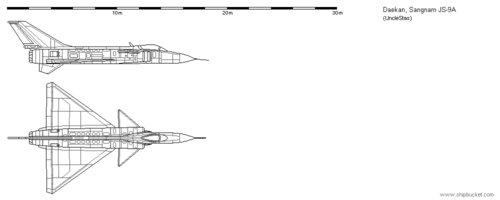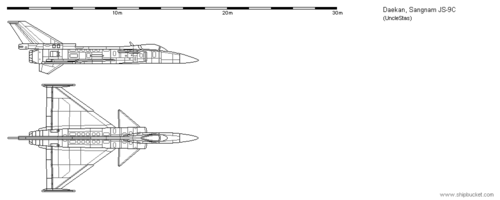Sangnam J-12: Difference between revisions
Jump to navigation
Jump to search
No edit summary |
No edit summary |
||
| Line 145: | Line 145: | ||
}} | }} | ||
{{Daekanese post-WW2 military aircraft|state=expanded} | {{Daekanese post-WW2 military aircraft|state=expanded}} | ||
Revision as of 02:07, 12 January 2021
This article is incomplete because it is pending further input from participants, or it is a work-in-progress by one author. Please comment on this article's talk page to share your input, comments and questions. Note: To contribute to this article, you may need to seek help from the author(s) of this page. |
| Sangnam J-12 | |
|---|---|
 Main J-12 variants (note the conformal fuel tanks on the C model) | |
| General information | |
| Type | fighter, Multirole Fighter |
| Manufacturer | Sangnam Aircraft Design Bureau |
| Status | In service |
| History | |
| Manufactured | 1992-today |
| Introduction date | 23 May 1995 |
The Sangnam J-12 (전투기 12; Jeontugi 12; Fighter (No.) 12) is a single-engine, lightweight multirole fighter aircraft in the delta and canard configuration, developed and produced by the Sangnam Aircraft Design Bureau for the Daekanese People's Army Air Force. It entered service in 1995 and forms the backbone of the DPAAFs frontline fighter units alongside the heavier Anseon J-14.
Origins and development
Design
Airframe
Engines
Electronics and Avionics
Operational history
 Daekan: The Daekanese People's Army Air Force is the main operator of the J-12, with 80 J-12As, 100 J-12Bs and 40 J-12Cs in service.
Daekan: The Daekanese People's Army Air Force is the main operator of the J-12, with 80 J-12As, 100 J-12Bs and 40 J-12Cs in service. Pakiranistan: The Pakiranistani Air Force is the second largest operator of the J-12, with 100 J-12PI, 38 J-12PS, and 30 J-12PNG in service.
Pakiranistan: The Pakiranistani Air Force is the second largest operator of the J-12, with 100 J-12PI, 38 J-12PS, and 30 J-12PNG in service. Kamdai: The Kamdai Air Force operates up to 100 J-12 of different variants/
Kamdai: The Kamdai Air Force operates up to 100 J-12 of different variants/
Variants
Domestic variants
- W-012-1: Prototype variant. It did not feature canards
- W-012-2: Second prototype variant. Canards were added and the ventral fins were extended
- J-12A: Initial production variant, featuring the LS-78 pulse-doppler radar and Yolam-52A engine.
- J-12P: Two-seat variant of the J-12A.
- J-12B: Upgraded variant introduced in 2006. Includes a larger nose cone to accommodate the new LS-86 pulse-doppler radar, modified vertical stabilizer with housing for an extensive avionics and ECM suite, the more powerful Yolam-60 engine, as well as extended engine cover. Has the capacity to mount conformal fuel tanks.
- J-12PB: Two-seat variant of the J-12B
- J-12C: Latest variant, introduced in 2014. It features a slightly enlarged cockpit for better visibility, lighter and stealthier diverterless supersonic inlets, modified wings with extended leading-edge slats and wingtip hardpoints for missiles. Additionally, it has an improved avionics suite, the upgraded Yolam-60B engine and the new LS-92 active electronically scanned array (AESA) radar.
- J-12PC: Two-seat variant of the J-12C
- J-12D: Upgrade program currently under development. The program includes a new, improved canard design, a 3-D vectoring engine, extensive RAM coating and improved avionics. The prototype flew in January 2020.
- J-12H: Carrier-borne variant based on the J-12B under consideration by the Daekanese People's Army Naval Air Force (DPANAF) for use in the new Jang-gun-class of aircraft carriers.
Export and foreign variants
- J-12S: Export variant of the J-12A offered since 1998 featuring the LS-76 radar. Two-seater variant is the JS-12PS
- J-12SB: Upgraded export variant offered since 2009. It is based on the J-12B, and features the LS-86E radar. Two-seater variant is the JS-12PSB
- J-12SC: Latest export variant offered since 2015. It is based on the JC-12C, and features the LS-91 active electronically scanned array (AESA) radar. Two-seater variant is the J-12PSC.
- J-12PI: Pakirani variant based off of the J-12S, the aircraft has been modified and reequipped for the light interceptor role, it features Pakirani avionics and the AASR-95 radar
- J-12PS: Pakirani Two-Seater variant based off of the J-12PS, the aircraft has been adapted to the strike role, and features the Pakirani ATSTR targeting pod as well as fuselage mounted bomb racks.
- J-12PNG: Latest upgraded Pakirani variant in service since 2012, It is based on the J-12PI, the aircraft features avionics improvements such as the helmet-mounted display and sight (HMD/S) system, the cockpit has been overhauled into one single Multi-Function Display (MFD), as well as incorporating the NGAASR active electronically-scanned array (AESA) radar with rumored infrared search and track (IRST) system capability.
Specifications (J-12B)
General characteristics
- Crew: 1: pilot
- Length: 17.33 ()
- Wingspan: 10.13 ()
- Height: 4.84 m ()
- Empty weight: 10,000 kg kg ()
- Loaded weight: 14,000 kg ()
- Max. takeoff weight: 19,500 kg ()
- Powerplant: 1 × Hyesan Yolam-52A afterburning turbofan
Performance
- Maximum speed: Mach 2.2 (2,336 km/h, 1,451 mph) at high altitude/ 1,110 km/h (690 mph) at low altitude
- Range: 3,600 km with drop tanks ()
- Combat radius: 1,550 km with drop tanks ()
- Service ceiling: 18,000 m (59,000 ft)
- Rate of climb: 310 m/s (61,020 ft/min)
Armament
- Guns: Provision for 2× 27 mm CR-127 cannon, 130 rounds per gun
- Hardpoints: Total of 11: 6 under-wing, 4 under-fuselage, 1 centerline; with a capacity of 7,300 kg (16,093 lb) external fuel and ordnance (C variants have two additional wingtip hardpoints) and provisions to carry combinations of:
- Missiles:
- Air-to-air missiles:
- Air-to-surface missiles
- Bombs:
- MP series of dumb bombs (250 kg and 500 kg bombs)
- GB series of dumb bombs (150 kg, 250 kg, 500 kg and 700 kg bombs)
- YP-5 laser guided bomb
- GGB series of laser guided bombs (250 kg, 500 kg and 700 kg bombs)
- GP-7 glide bomb
- Other:
- LP-20 rocket pod
- LP-32 rocket pod
- Various fuel tanks (up to 3)
- Missiles:
Avionics
TBA


